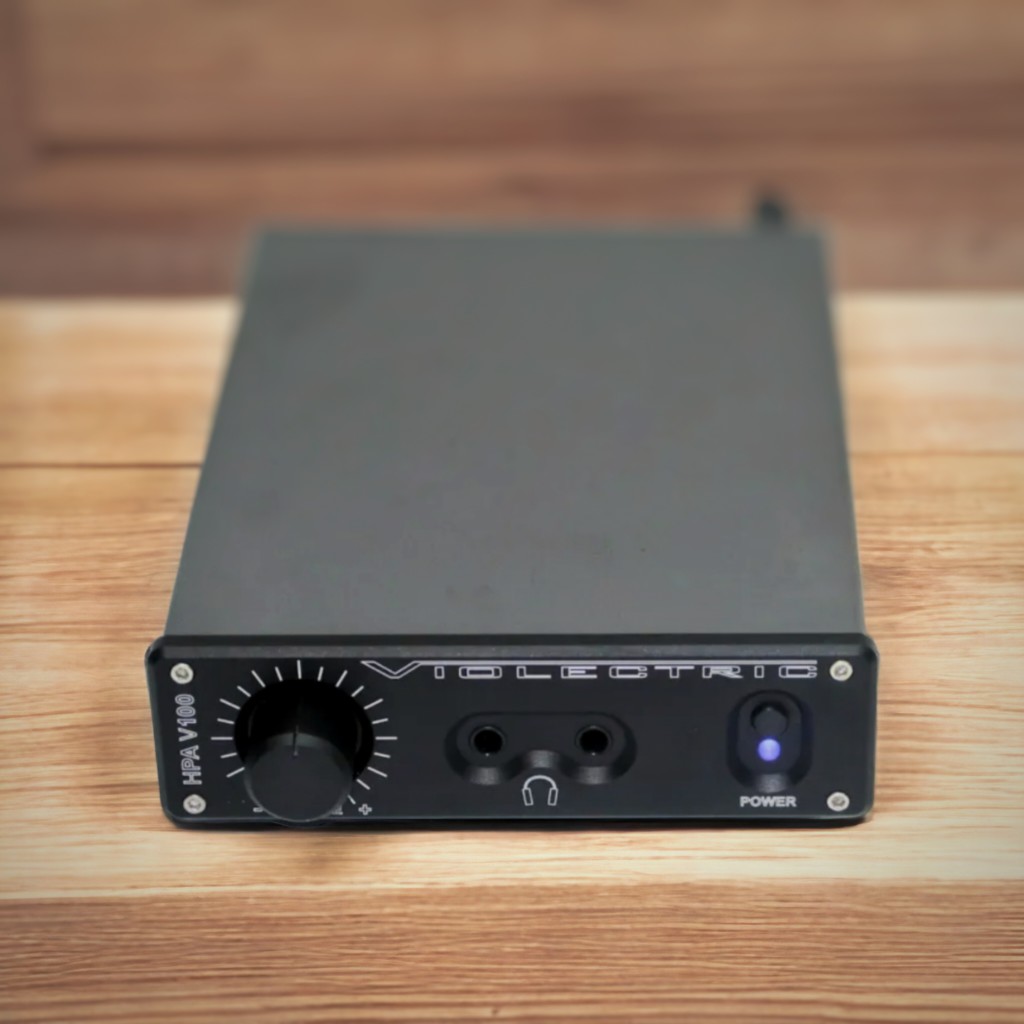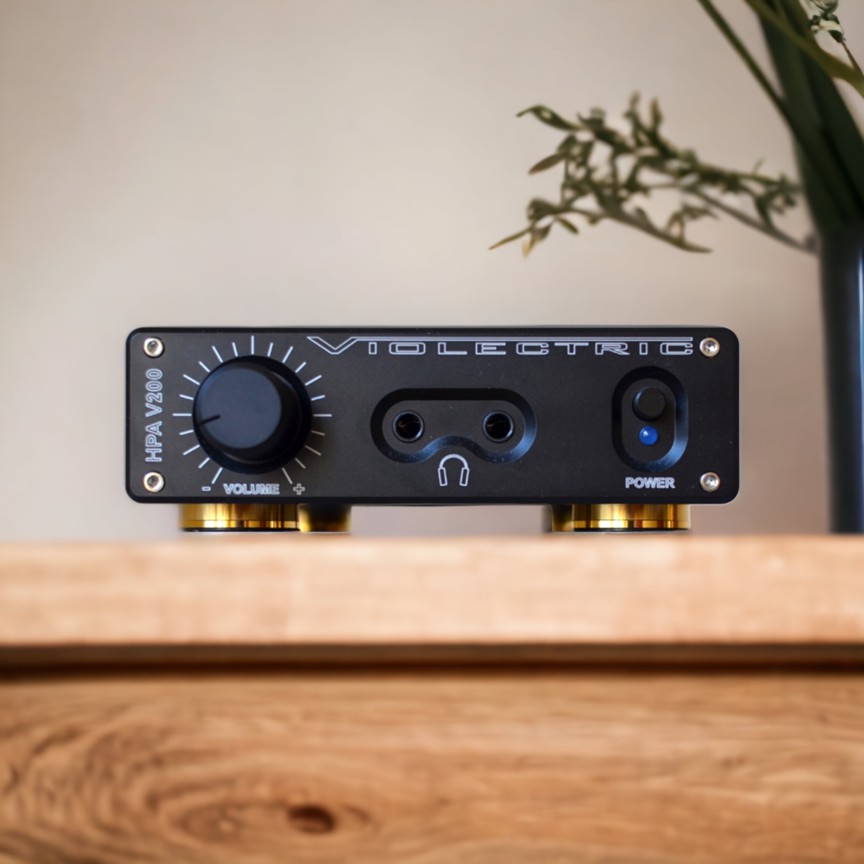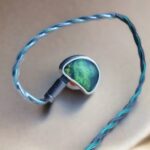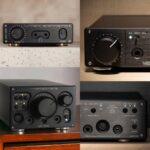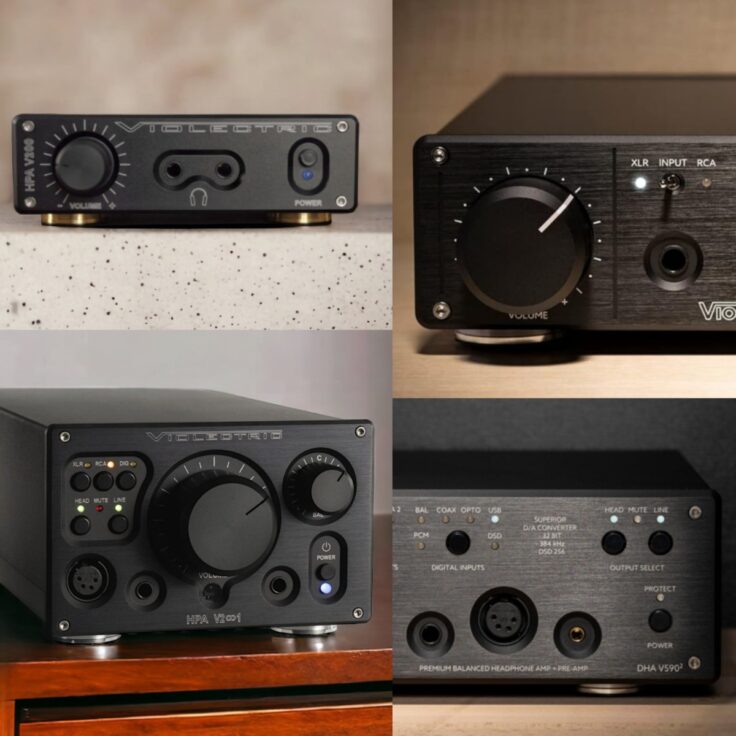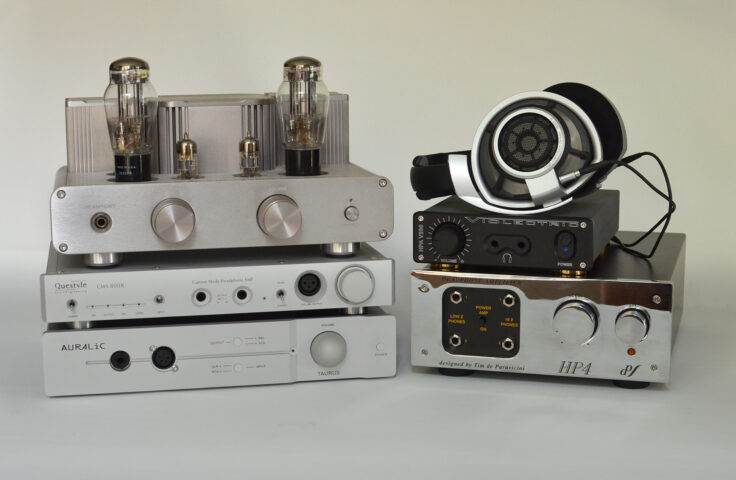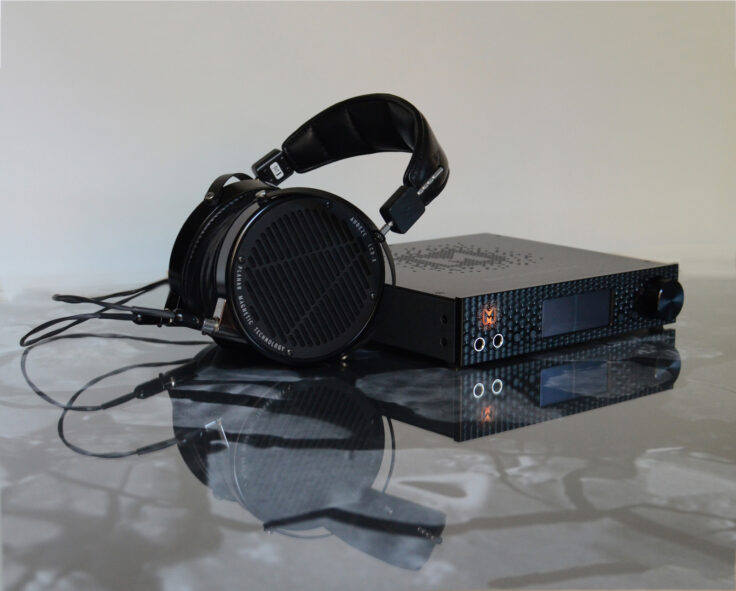THE GAME CHANGER
Violectric V200 is a long-standing reference amp for many, including myself. It is now discontinued. Its successor V202 was launched in 2022 and is a tweaked, modified and compactified V200. I’ll come back to that later.
I have long wanted to write a review of the Violectric HPA V200, as I’ve used it as a reference in nearly every review on this site. Nevertheless, I never found the time to write a dedicated piece about this fantastic little amp. Until now.
First a few words about Violectric. It is a German audio equipment company, or rather a consumer-focused sub-brand of Lake People, a professional audio electronics manufacturer. Both are creations of chief engineer and CEO Fried Reim, who still is running the shop
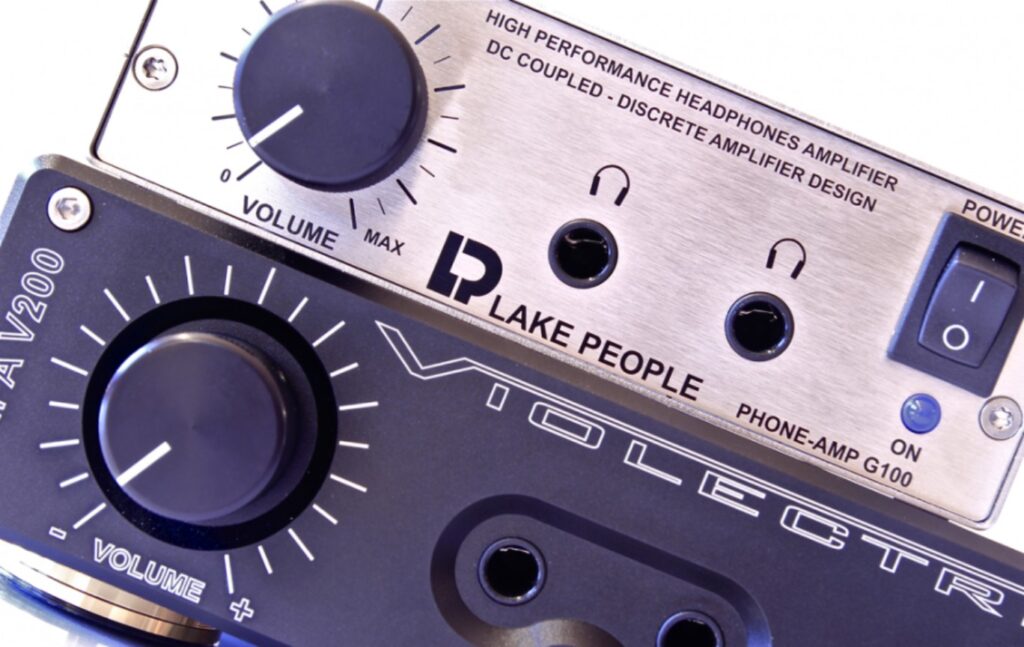
The Violectric V200 was the successor of the almost identical looking Violectric V100, which in turn was based on the Lake People G100 professional headphone amplifier.
Both V100 and V200 are relying on transistors for the output power. They are using op-amps, but they are not “op-amp-based” amps. Op-amp based amps actually use the opamps to provide the power to the headphones. The V100 and V200 are discrete designs using power transistors to provide the output power. They do however use op-amps in different stages to control voltages and also a pair on the input and outputs for gain.
The main difference between the V100 and V200 is that the V100 uses only 4 transistors for the power stage in a quite “regular“ arrangement, while the V200 uses 8 transistors per channel in a much more sophisticated circuitry. It is a discrete design manufactured with THT methods (more on that later).
It is not a coincidence that I chose to brush some dust off the V200 now, because the “bigger younger brother”, the HPA V281, is going to be reissued in a limited number this year. The V281 is essentially an upgraded dual mono V200. When I reviewed it in 2017, I found it to be a fantastic amp. It’s a V200 on steroids. And now I want to honour the V200 – the original.
The Violectric V200 was launched in 2009 and soon gained popularity. It was very versatile. Powerful both in terms of Wattage output and Voltage swing across all headphone impedances and had an output impedance of an insanely low 0.06 ohms, which was very unusual at the time – and still is. Low output impedance increases the damping factor which is good for a linear sound response.
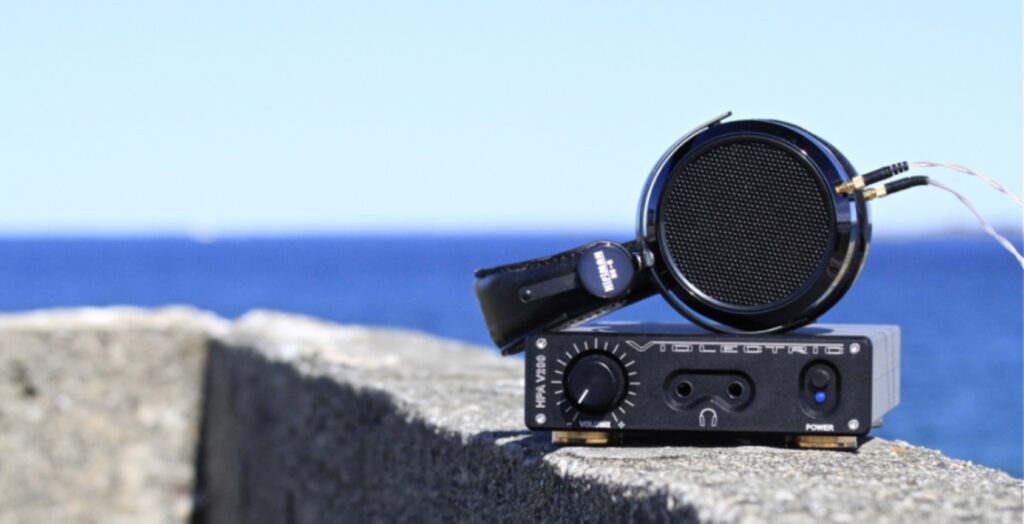
This was at the beginning of the era of planar magnetics, with LCD-2 (2008) and HE-500 (2011) as the two most popular headphones. The V200 drives these close to perfection and at the same time, it does full justice to the main high-impedance dynamic flagship, the 300 ohm Sennheiser HD800 (2009). Also, the most popular low-impedance flagship back then, TH-900 (2011) sounds fabulous. Even the notoriously hard-to-drive Hifiman HE-6 (2010) isn’t lost with the V200. In other words, the V200 was a great match for all the headphones that mattered at the time and it still is great for basically all headphones that matter today.
The V200 has a smooth and lush but still very neutral sound signature with great control and detail. Some describe it as tube-like. It plays well with headphones of all kinds of impedance and sensitivity. It’s dead silent and perfect for sensitive IEMs.
The exterior design of the V200 is very simple and elegant in a utilitarian way which I personally find extremely appealing. Especially so when matched with the discontinued V800 and V850 DACs – which also sound terrific.
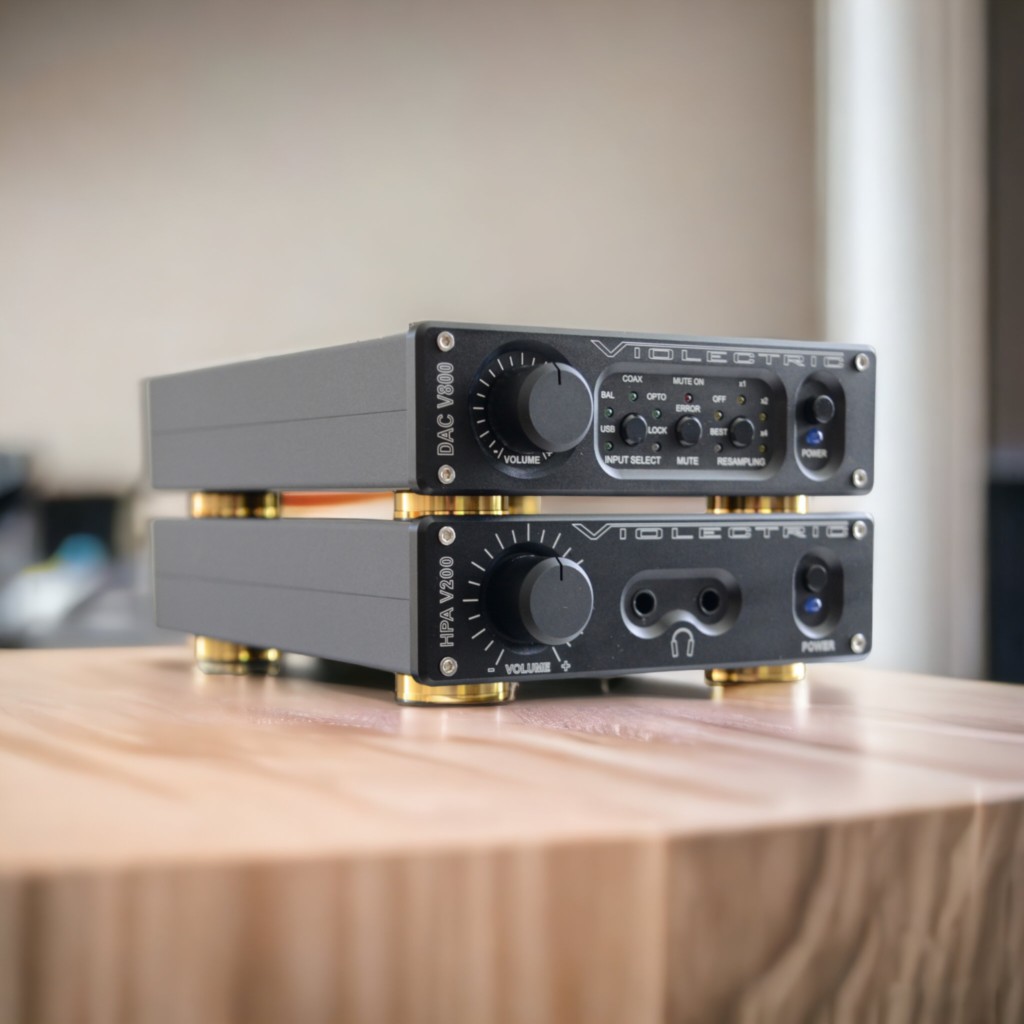
TECHNICALITIES
The V200 is built like a tank. It is rather compact and has a volume control knob, a power button and two 6.35mm TRS connectors in front. On the back, you find both unbalanced and balanced inputs. There are gain switches on the back and room for a digital input. You can also use it as a pre-amplifier if you switch an internal switch. Then the unbalanced inputs become preamp outputs. The dimensions are 170 x 49 x 225 mm (W x H x D).
The output impedance is as mentioned only 0.06 ohms and the amplifier is quite powerful. Here are the numbers for the maximum output level:
- 600 ohms: 570 mW
- 100 ohms: 2200 mW
- 50 ohms: 2700 mW
- 32 ohms: 2000 mW
- 16 ohms: 1000 mW
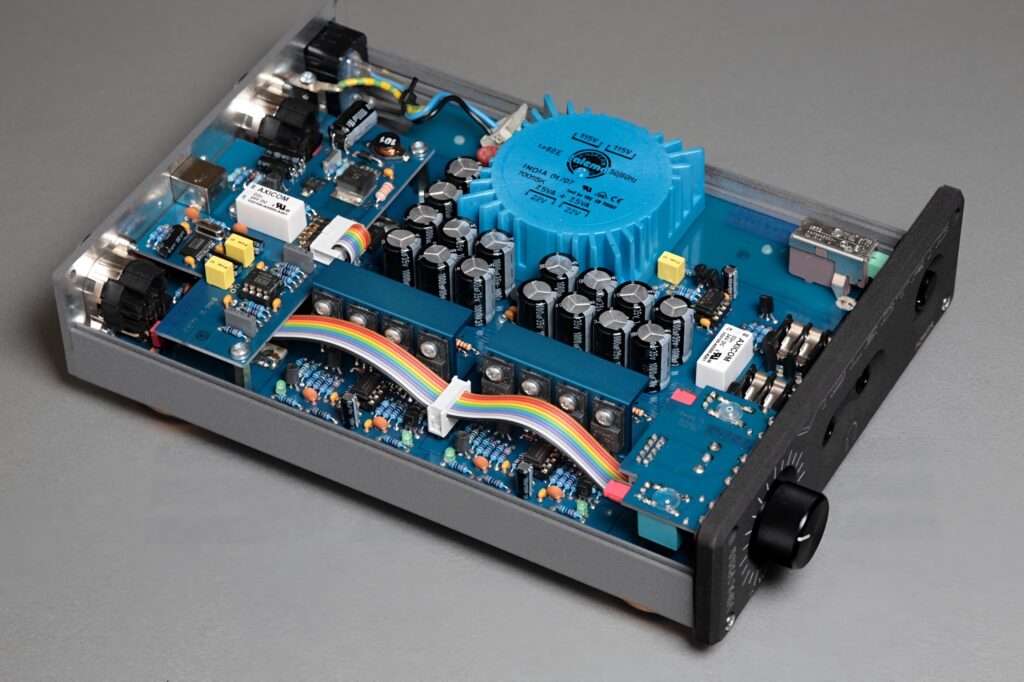
As mentioned above, the internals of the V200 revolve around a quite unique 8-transistor amplifier section powered by a toroidal transformer. Here’s a quote from the chief designer Fried Reim:
“V200 incorporates a very sophisticated transistorized amp with 8 transistors per channel. The roots of this design go back to the late 70s with the Nakamichi Series 600 power amp. This was one of the first amps with stable idle current so no idle adjustment was necessary. Also they claimed a damping factor of 1000 which was sensational for the time. It was fast, reliable, and stable under any circumstances.
The amp modules or the V200 are powered from a toroidal transformer with 60 V (+/- 30 V) secondary voltage. This is about double as much as can be found in most competitors’ amps. So a high output voltage swing is enabled, which is necessary for high impedance cans.”
The V200 and all Violectric amps have current-limiting circuits as an important part of their internal design. This makes it possible to safely have a very low output impedance. You can see the current limitation on the power figures which go down after 50 or 100 ohm loads.
With no current limitation the amps/power supply would be damaged with impedances lower than 50 or 100 Ohm.
The alternative is using resistors for current limitation – resulting in much higher output impedances. Lower output impedance is not the only advantage of the Violectric current-limiting circuitry: Due to the current-limiting circuits, Violectric amps are short-circuit proof under nearly all circumstances.
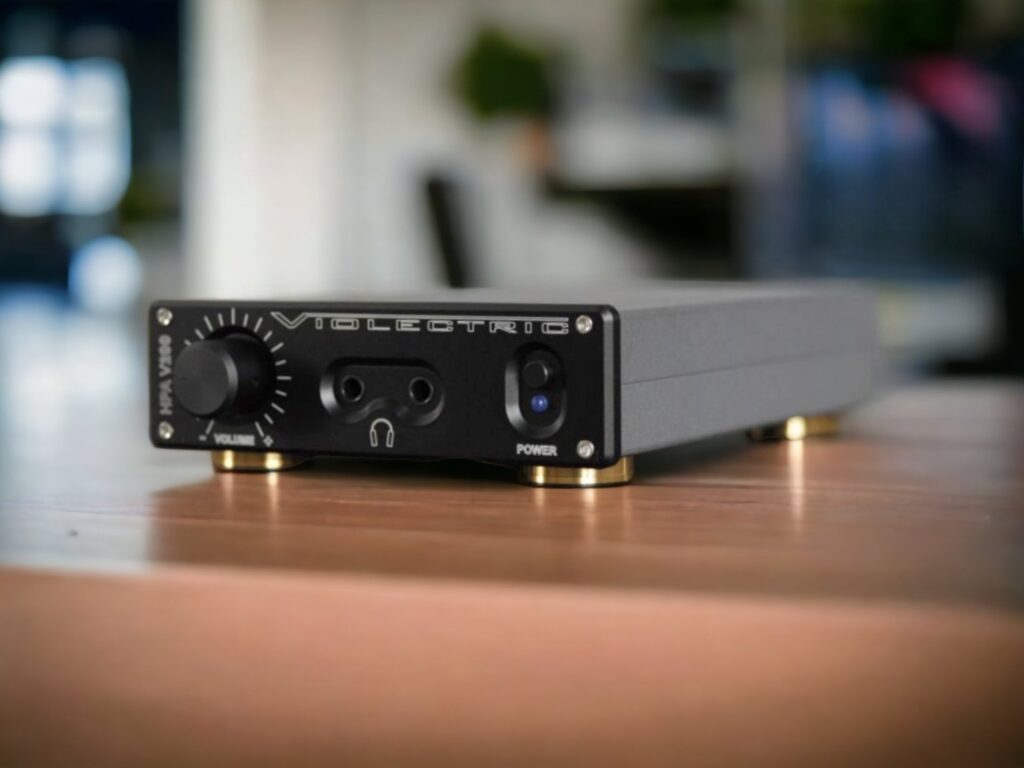
The V200 remained unchanged throughout its lifespan except for a few different versions of the faceplate and the volume control. There have been two versions of the volume control. First, the V200 had an ALPS RK27. In November 2011 Violectric started making amplifiers with a specially made 41 detent pot from ALPS. The outside knob also changed.
Following the success of the V200, Violectric made several new amps based on the V200 amplifier circuit. For reference the V200 is 2.7 W @ 50 ohms:
- V220 – This is basically a V200 with a bigger PSU and thus more power. The chassis is the same width but more than twice the height of the V200. It is also deeper. The chassis is the same size as the V281. Output power in 50 ohms: 2.7 (this is the same as V200 but the V220 has higher but than the V200 at other impedances)
- V281 – This is a balanced, much more powerful version of the V200. It is basically a dual mono V200 with a huge PSU and some upgrades. The chassis is the same as the V220. Output power in 50 ohms: 4.2 W.
- V280 – This is also balanced and basically a scaled-down V281 in a V200-like chassis. Output power in 50 ohms: 3.1W
All these amps are now discontinued. Full power specs in various impedances are at the end of this article. Please note that the Violectric amplifiers are even more powerful at higher impedances.
There was a 10th-anniversary edition of the V200 released in 2019. This version is still in stock in a few places. In 2022, the successor to the V200, called the HPA V202, was launched.
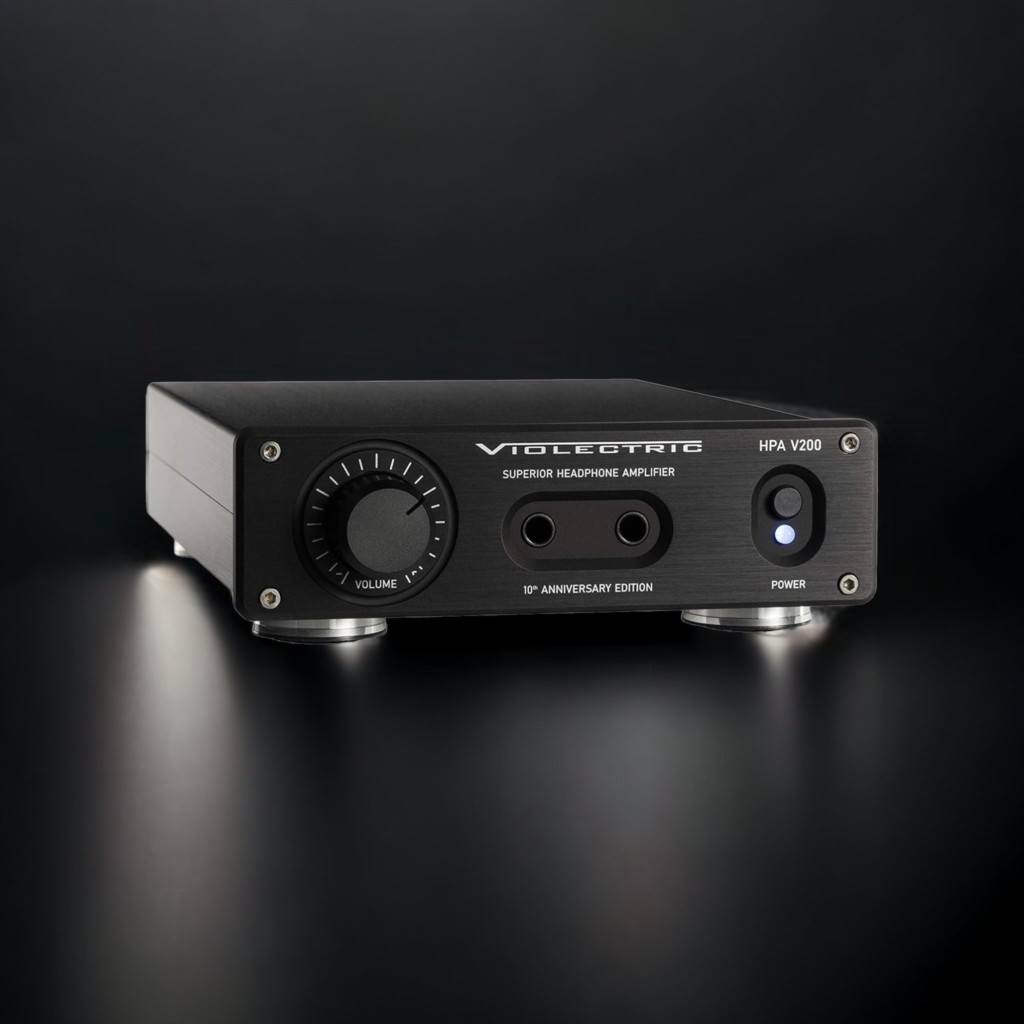
THE GREAT LEGACY OF THE HPA V200
Now, the V200 might be discontinued but it’s not because it wasn’t great: All current Violectric amps are based on the 8-transistor circuitry that was developed for the V200. Violectric calls it the V200 technology.
The V202 is using one V200 technology 8-transistor amp module. It is now more compact after they started building all Violectric amplifiers with SMD technology rather than with THT. All the older amps were built with discrete THT components. THT (through hole technology) involves inserting leads of components into drilled holes in the PCB and soldering them on the backside.
SMD means ‘surface mounted device’. These are pre-made modules that are soldered on the surface of the PCB, making it a more compact design.
To ease the production process, the amp circuit is now built as a stereo SMD module which is soldered to the PCB. SMD means ‘surface mounted device’ and these components are soldered on the surface of the PCB. They make for more compact designs than the THT (through-hole components), which was used on the older generation (V100, V200, V220, V280, V281).
All the amplifiers from Violectric have implemented current limitation, which makes them very safe and as mentioned, makes it possible to have a very low output impedance.
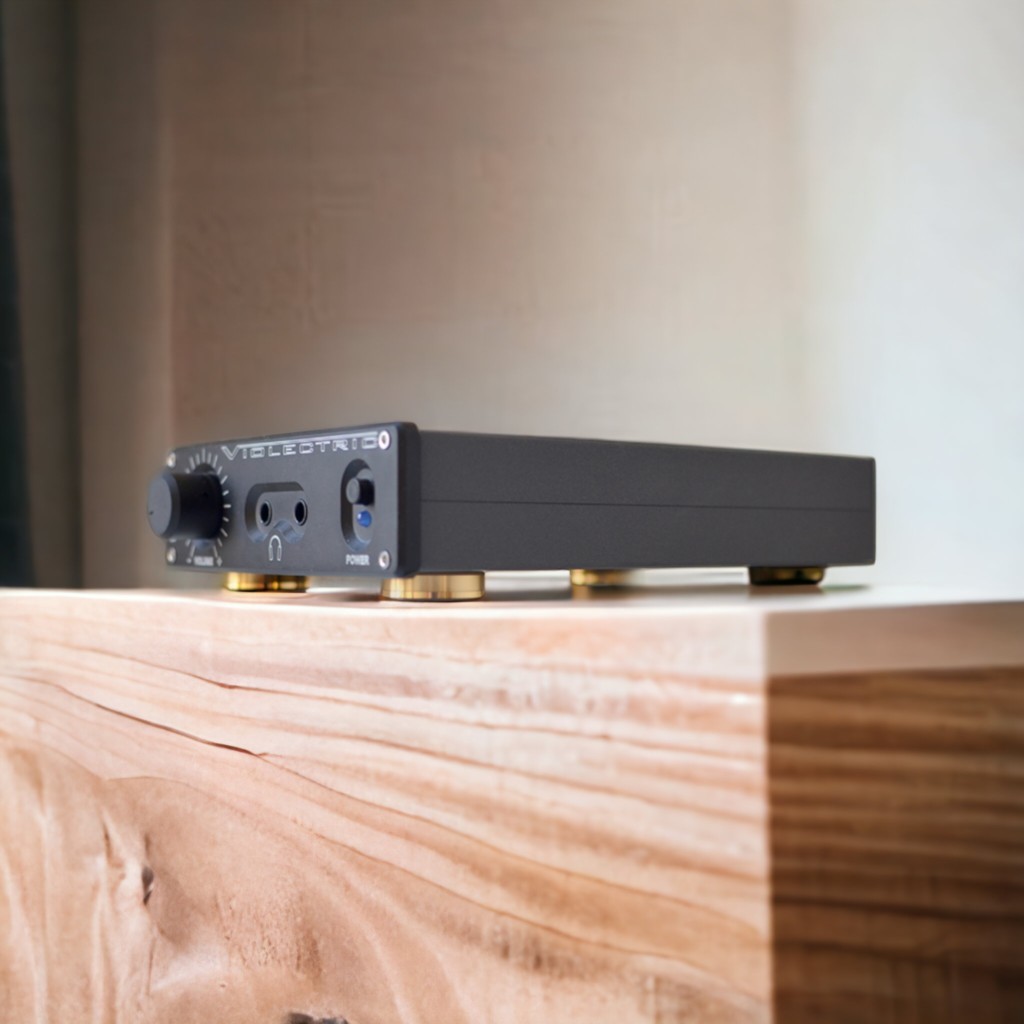
Violectric’s present amplifier lineup has internals that build heavily on the V200-generation, especially in that they are using one or more of the SMD-circuit version of the V200 amp module – in various configurations and with different PSU’s. The chassises are of course new, with better functionality.
- V202 – This new iteration of the V200 was launched in 2022. It’s based on the same amplifier circuit but tweaked and put into a more compact chassis with one (unbalanced) Pentaconn and one 6.35 mm jack output. There’s also an input switch, something the V200 lacks. The specifications are very similar (full specs at the end of this article). Power output at 50 ohms is 2.7W
- V222 – While V202, the true successor of V200, carries only one of the V200 amplifier modules, the balanced V222 and V226 have two of these modules. The V222 is the newer and smaller version of the balanced V280, although less powerful. The V222 has the same compact chassis as the V202 and comes with one Pentaconn, a 4-pin XLR and one 6.35 mm jack output and an input selector. Due to the compact size, it has only one toroidal transformer, not two as the V280. This results in less output power than the V280. Power output at 50 ohms is 2.8W.
- V226 – The exact same amplifier as the V222 but with a digital input instead of the balanced inputs.
- V340 – Basically a scaled down V550 in the same chassis. No balanced input, no remote control. Significantly more powerful than the V222 but less powerful than the V550. Power output at 50 ohms is 5W.
- V380 – V340 with a DAC
- V550 – This is the “true successor” of the V281. It has a remote control and balanced inputs. Power output at 50 ohms is 6.4W, even more than the V281.
- V550 PRO – This is a V550 with a 256 step volume control.
- V590 – This is a V550 with a DAC
Even though these models are true to, and even technically speaking, improvements over the original designs and thus sound very similar, many enthusiasts find that they sound more clean and “technical”. Some find they lack some of the charm and smoothness of the older models. This “charm” is probably a little dose of distortion but, as audio enthusiasts have come to know – a little dose of distortion can be very appealing, as long as it is good sounding distortion.
Whatever it is, the older models have something about them that has an appeal.
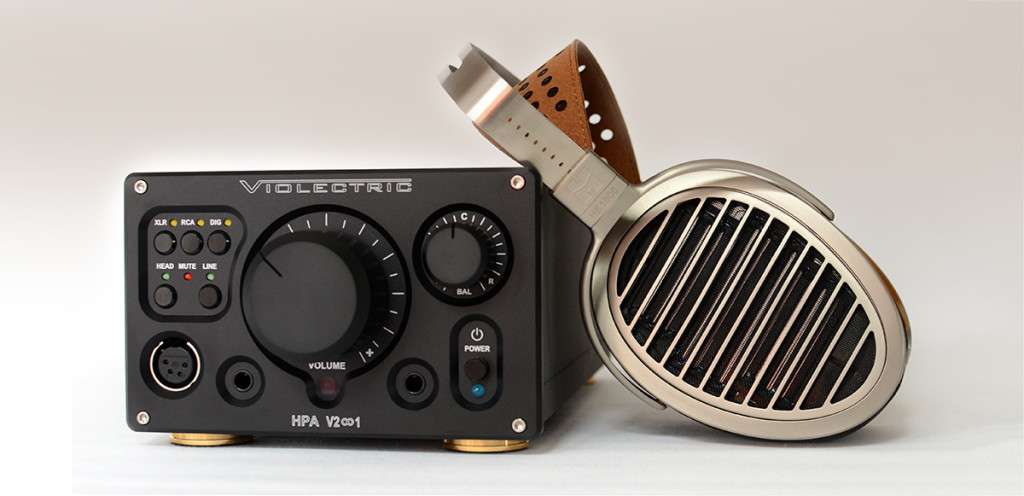
HPA V281 REISSUE
As I write this, the V281 is being brought back, at least in limited numbers. The North American distributor Power Holdings has convinced the Violectric team in Germany to make a limited edition of V281’s – with some improvements as well. Here’s what they say:
“Customers have been asking for years if there are any V281 left in stock. This model has been missed by many for its tube like warmth and slim form factor. So Violectric has decided to make 100 special edition units. At the request of many customers we have added some new features to make this iconic model even better.
The circuit design will be the same as the original for that iconic Violectric sound signature (Tube like warmth with a powerful tight bass punch).
The case will be the same form factor and design as the original. Measurements: 170mm W x 112mm H x 320mm D / 7″ W x 4.4″ H x 12.6″ D
New Features on the V281 Reissue:
- The case will be smooth brushed black anodized aluminum (No more gray nextel coating that chips off).
- The front plate will have Light-Edge milling (45 degree silver polished edge).
- The addition of a 4.4 Pentaconn balanced headphone connector (Along with the 4 pin XLR balanced and 6.3 unbalanced connectors).
- A second RCA unbalanced input (Now with 2 x RCA unbalanced inputs and 1 x XLR balanced input).
- A relay volume as standard with REED relays (no more mechanical clicking when adjusting the volume).
- Additional gain setting of +/- 18db (now with three gain settings +/- 6, 12, & 18 db).
- The input voltage can be set to 115v or 230v via an internal switch (just remove the top cover to access).
- The new style small aluminum remote control included.
Unfortunately, Violectric has only decided to make 100 of these amplifiers. The form factor alone is a good argument to keep it in person in my humble opinion. It can only be purchased from Power Holdings distributer here. The demand will show if it’s successful – If so let’s hope they make more. I was thoroughly impressed with it when I reviewed it in 2017:
Well, that’s enough about the mighty V281. This article is about its direct predecessor, the amplifier that made Violectric a household name in headphone enthusiasts’ homes: Let’s get back to the V200.
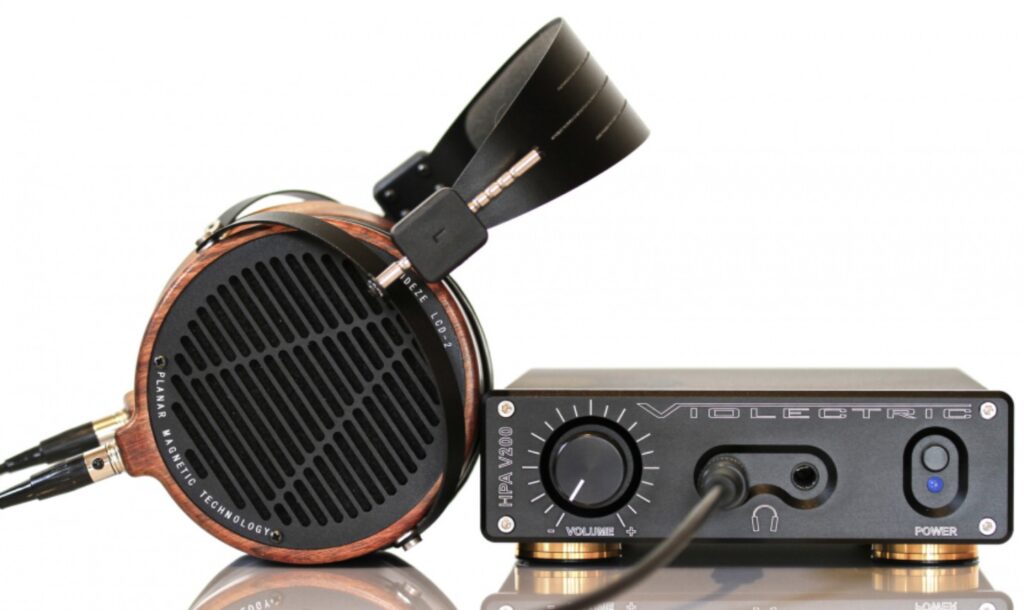
HEADPHONE PAIRINGS
The HPA V200 can drive any dynamic or planar magnetic headphone. I have already mentioned several great matches but from the top of my head I’ll here’s a brief list of headphones that I personally have found to be very well suited for the V200:
- Audeze LCD-2, LCD-3, LCD-X
- Hifiman HE-500, HE-6, HE-560, Ananda
- Oppo PM 1
- QUAD ERA-1
- AKG K701
- Sennheiser HD800
- Focal Elear
Again, everything basically sounds good with it in my experience. These were only examples of my personal favourite matches.
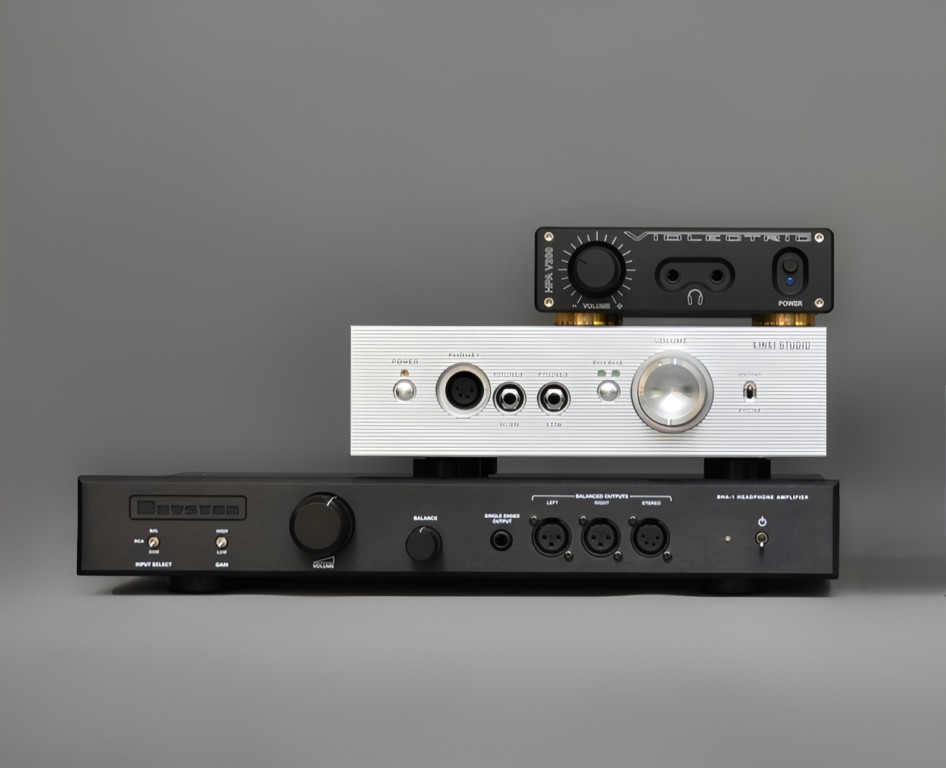
COMPARISONS
In the following is a selection of comparisons I have written over the years. I picked out those that compare the Violectric V200 to amplifiers that are in production as of today, in 2023. They are not written at the same time, but they should give you a good idea of how it performs.
SPL Phonitor xe vs Violectric V200
The SPL Phonitor xe houses the same powerful balanced headphone amplifier as the Phonitor x and Phonitor e. It has several unusual features like a unique crossfeed-angle matrix and both rear and front headphone outputs. The Phonitor xe is available with an optional high-end DAC.
For this comparison, I use the Violectric V800 DAC as a source for both the Phonitor and the V200.
Let’s see how I found the Phonitor xe to compare to the V200 when I tested them with various headphones:
I started with the Audeze LCD-3. The tender improvisations that constitute the track “Fluorescent” by Dans Les Arbres is a delicious collection of sounds. The Phonitor delivers a full, organic and spacious experience. It feels warm and welcoming, spacious and nuanced. Even though the V200 is a great amp, it somehow sounds flatter and less organic. There is a better sense of flow, of breath, of timbre with the Phonitor. The Phonitor sounds more at ease, more natural and, for lack of a more precise word: free.
Moving through my playlist, my first impressions are mirrored, The Phonitor is more organic, more relaxed, more spacious and natural sounding. In other words, the Audeze LCD-3 sounds sweeter and even more delicious with the Phonitor than with the already good V200.
I immediately fell in love with the way the Phonitor drives the Sennheiser HD800. Most of what I said about the difference between these amps with the LCD-3 applies to the HD800 too. The sometimes quite fatiguing HD800 can spend hours and hours on my head with the Phonitor.
Moving on to the Hifiman HE1000v2, the Phonitor again has a much warmer and more organic-sounding presentation, yet retaining detail and transparency.
IN CONCLUSION: The V200 is a great amp, but the Phonitor xe is even better. It’s warmer and more organic sounding, yet still more detailed and spacious. It is also a lot more expensive so one should expect no less.
Kinki THR-1 vs Violectric V200
Kinki Studio is a small Chinese manufacturer of hifi DACs, amps and pre-amps. The company was established in 2008 and has become an established but small supplier of quality HiFi products. The THR-1 is a quite powerful headphone amplifier with preamp functionality. It has three headphone outputs: A 4-pin XLR and two 6.3mm TRS outputs. The TRS outputs are optimized for higher and lower impedance headphones and thus labelled “High” and “Low”. On the back, there are XLR and RCA inputs and outputs.
Let’s see how I found the Kinki THR-1 to compare to the V200 when I tested them with various headphones:
Hifiman Sundara
I tend to favour the Kinki: It is warmer, fuller and more pleasant sounding. Voices have more weight and body. Even though the V200 is not dry or bright sounding, it lacks the midrange weight of the Kinki.
Oppo PM1
I feel similarly to the above, the Kinki is simply more charming, more inviting and enveloping. They feel equally snappy and detailed, but the Kinki infuses a dose of charm into all the music I play.
Focal Elear
The Elear sounds better with the Kinki. It has a more organic fluidity, the V200 can become a bit dry. The detail level feels similar.
Hifiman HE560
Shostakovich: String Quartet No. 3 & Piano Quintet – Belcea Quartet: This track is quite different with the two amps: The strings have more texture with the V200, which has a drier presentation. The Kinki is a bit more laid back and feels a bit more organic.
Faces – T. Stanko: The V200 sounds more transparent and detailed. The Kinki is nice but makes the HE560 less open-sounding.
Mars – Soulfly: Playing some metal, the difference is obvious. The V200 is quite a bit tighter sounding with the HE560 than with the Kinki.
I Do – S. Slettahjell: With toned-down female vocals, it is the Kinki´s turn to show off. It does indeed have some seriously smooth midrange capabilities.
I struggle to make up my mind about which I really prefer with the HE560. The Kinki has a richer tone, but sometimes the V200 feels cleaner and more effortless in its presentation.
Sennheiser HD800
Montague Grant – Prins Thomas: The amps perform quite similarly on this bass and drums-oriented track. The Kinki sure doesn ́t stand back to the V200.
Terminal 7 – T.Stanko: They are equally spacious sounding, but the Kinki has a sweeter and more appealing sound signature. The midrange is especially nice, but also the treble feels more organic. The resolution feels similar.
Nevermind – L.Cohen: Again, the extra level of sweetness of the Kinki makes me a bit more happy than the V200.
Can´t You See – Susan Wong: Here, the crispness of the V200, with the extra texture it gives the vocals, feels more desirable to me than the Kinki´s fullness.
Grålysning – T. Thonstrup: Here, I find the V200 to be more effortless, the Kinki a bit less controlled.
Mostly, I prefer the Kinki to the V200 side-by-side, and I definitely prefer the Kinki for longer sessions. It has a much sweeter and more pleasant sound signature.
Beyerdynamic T1 mk2
Although the T1 mk2 sounds quite alright with the V200 it takes me a very short while to conclude that the Kinki is superior. It is sweeter sounding, with a more lush and inviting, yet clean and transparent presentation. There is nothing negative to say about the Kinki/T1 combo. It is simply delicious.
IN CONCLUSION: Often I found the Kinki warmer and more organic sounding whilst the V200 was more neutral and textured sounding. However, it depends on the headphones which I prefer.
Bryston BHA-1 vs Violectric V200
The Bryston BHA-1 headphone amplifier was launched back in 2012 and immediately gained a standing as a solid high-end performer. Unlike most brands, Bryston has not bothered with releasing new versions of an already great product.
The BHA-1 is not a small amplifier because the chassis is in the standard 43 cm standard hifi-component width. It seems very solidly built and given that Bryston offers a 20-year warranty that is no surprise. The BHA-1 has three analogue inputs: RCA, XLR, and 3.5mm minijack. It has a high and a low gain setting. There are 4-pin and dual 3-pin balanced XLR outputs and a standard 1/4-inch TRS jack.
The amp is powerful but still dead silent, even with sensitive headphones and earbuds.
Let’s see how I found the Bryston BHA-1 to compare to the V200 when I tested them with various headphones:
Audeze LCD-3
Terminal 7 – T.Stanko: The V200 has always been good with planar magnetic headphones, and it does not disappoint now either. With the LCD-3 it to me has a slight advantage over the Bryston because it is a bit warmer sounding, without losing spaciousness and detail.
Edmond – Prins Thomas: This bass-heavy track reveals how impressively well the Bryston handles bass; the V200 gets a bit looser own below in comparison.
Violin Concerto D major. Op 35.1 – Tchaikovsky/Hahn: The Bryston certainly has a brighter presentation. However, both feel equally spacious and detailed.
Generally, I tend to prefer the V200 for the LCD-3 for its warmer feel, but the Bryston has better bass control.
Hifiman HE1000v2
4:30 AM – S.Slettahjell: The Bryston sounds quite a bit more open and resolved when I have the V200 at normal gain. Adding 6 dB helps, and narrows the gap, but still, the Bryston is better.
Edmond – Prins Thomas: Both do very well, the bass performance is great.
3 Madrigals for Violin and Viola – H313.1 – Martinu/Emerson String Quartet: With this string trio, the Bryston reveals more of the recording, there is more space between the strings, the background feels blacker and there is a bit more detail in each stroke.
Sennheiser HD800
The Bryston does very well with the HD800, and even though the V200 is good, the Bryston is a step up. With string music, the treble is more lively. Moving through other music the Bryston is more dynamic and fun. There is not always too much of a difference, but sometimes it is quite apparent.
I continue with the Focal Elear, Fostex TH900, and Beyerdynamic T1. The pattern continues, I’d be repeating myself if I were to write it out.
IN CONCLUSION: Even though the amps are close in their overall presentation, the Bryston is generally clearer and cleaner, with better dynamics and tighter bass control. The V200 is sometimes slightly fuller sounding, the Bryston being dead neutral.
Schiit Jotunheim 1 vs Violectric V200
Okay, the Jotunheim has been upgraded to a new version, Jotunheim 2, since this review but I include it anyway. It is a modestly priced but powerful headphone amp and preamplifier with balanced and unbalanced output and input and an optional DAC.
I used the Mytek Liberty DAC as a source. Let’s see how I found the Jotunheim to compare to the V200 when I tested them with various headphones:
Denon AHD-7000 (unbalanced)
The classic Denon rocks big time with the Jotunheim. Kate Tempest´s “Europe is Lost” is really immersive. Moving over to the V200 opens it up a bit, but not that much. All through the playlist, the V200 is a bit better in most ways. There is a little more space and detail, but also a bit drier sound.
Hifiman Ananda
The Jotunheim is no slouch with the Ananda, but in direct comparison, the V200 clearly gets the upper hand. The bass is a lot tighter, the soundstage is more precise and deeper.
Audeze LCD-2 rev.1 (unbalanced)
The V200 is a bit clearer and spacious, the Schiit a bit warmer. I prefer the V200.
Focal Elear (unbalanced)
The V200 is more open, it is tighter and more spacious. With the Jotunheim there is less blackness between instruments, and the bass is not as textured. The midrange is fuller, which in many ways is nicer. But the V200 defends its price tag.
Beyerdynamic DT1770PRO
Again, the Jotunheim is a nice performer, tuned a bit warmer than the V200, which comes out cleaner but somewhat less enveloping. The V200 has tighter bass and a blacker background, but there is something about the Jotunheim – it feels a bit more rounded and enveloping.
Sennheiser HD660S
The Jotunheim is good with the 150 ohm HD660S but the V200 is clearly the better amp. It is more open, and resolved, with tighter bass, and better imaging.
Sennheiser HD800 (balanced and unbalanced)
Wow – this was a surprise. I like the HD800 with the V200 amplifier very much and didn´t expect the Jotunheim to get close. But I find the difference between the two amps to be smaller with the HD800 than with the headphones I’ve tried so far. Maybe it is because the warmish sound signature plays well with the HD800. Maybe it is because, as I noted when comparing the Jotunheim to the Mytek Liberty DAC, the Jotunheim plays well with higher-impedance cans. Anyhow, the HD800 is a treat on the Jotunheim, and moving over to the V200 does not improve the HD800 too much. The separation on the V200 is still better, but the overall presentation by the Jotunheim is very nice. I also like the treble better, it is less dry and more rounded – but it must be said I often find the HD800 too bright. Going back to unbalanced TRS on the Jotunheim still leaves the same impression. Very impressive Schiit.
Beyerdynamic T1 mk2
As with the 300 ohm HD800, the Jotunheim is great with the T1. I actually tend to prefer the Jotunheim. It is a bit fuller, and the V200 is a bit thin. This is a common problem with the T1, which is notoriously hard to match properly. There might be a tad more resolution with the V200, but the overall impression is certainly not to the disfavour of the Jotunheim. Great Schiit.
Sennheiser HD650
Another high impedance can that grows with proper amplification matching is the 300 ohm HD650. Not surprisingly, the Jotunheim performs great compared to the V200 also here. The is a little bit more openness from the V200, but overall, I must say I might even prefer the Jotunheim.
Audeze LCD-X (balanced)
In my last comparison, I go back to a planar magnetic headphone. The LCD-X is a very low impedance can. The V200 outperforms the Jotunheim by a quite clear margin, confirming my impression that the Jotunheim punches above its weight with high impedance cans, not so much with planars.
IN CONCLUSION: The Jotunheim performs significantly better with the high impedance headphones than with low impedance, but even though it has an appealing warm and full-bodied sound it doesn’t outperform the V200 in either category. The V200 is the clearly best all-around amplifier being both tighter and cleaner sounding.
Heed Canalot III with the Obelisk PX Power Supply vs Violectric V200
The Heed Canalot III is a small headphone amp and includes a wimpy-looking switch mode PSU. It’s not necessarily bad, but the distributor wanted me to try it with a better power supply. To give it the best possible condition, I use the Heed Obelisk PX PSU, which is big and expensive. I’ll go a round below with the standard X-PSU l.
As a source for both amps, I use the Violectric V800 DAC. Let’s see how I found the Heed Canalot III with the Obelisk PX PSU to compare to the V200 when I tested them with various headphones:
Oppo PM-1
Faces – Tomaz Stanko: The Heed really shines here. The V200 is good, but the dynamics, smoothness and warm spaciousness of the Heed combo really make this one a delight to listen to. The Violectric is less lively and flatter sounding, although they are not miles apart.
Young Vivaldi – Concerto in D-minor RV813 Allegro Adagio – Modo Antiquo: Again, the V200 sounds good, but the Heed is more organic and lively, without having me feel that I miss anything. It is simply an open and detailed presentation with that nice dose of warmth that makes audio lovers really smile.
Midnight City – M83: The V200 is again slightly flatter sounding, the Heed a bit warmer and fuller. But the difference is not very obvious.
Audeze LCD-X
Reunion – M83: The Heed is more organic and generally even nicer than the V200.
Who says words with my mouth – Gunhild Seim: The V200 and the Heed are in a similar sonic landscape (as they always are), but the Heed feels more organic.
Building bridges – Ill Considered: This song is just an electric guitar, some percussion, and a trumpet, and sounds similarly great on the two amps. But again, the V200 is a tad drier.
Sennheiser HD650
Upstart – Ill Considered: Quite similar presentations, but I tend to prefer the Heed.
Terminal 7 – Tomasz Stanko: The Heed is more organic and more alive sounding.
Young Vivaldi – Concerto in D-minor RV813 Allegro Adagio – Modo Antiquo: Here I tend to prefer the V200 because it has this drier, more textured tone that makes the strings a tiny tad more tactile. But, another day I just might switch preferences. Both are great.
Sennheiser HD800
Young Vivaldi – Concerto in D-minor RV813 Allegro Adagio – Modo Antiquo: I always loved the V200 with the HD800, and here it is wonderful. The Heed is too – they are not really very different. The Heed sounds a tad fuller, and it certainly is purely a matter of taste which to prefer.
Terminal 7 – Tomasz Stanko: A very pleasing presentation from the V200, open, spacious, warm and enveloping. The Heed is very similar in all aspects, but a tiny tad warmer sounding.
Giver – K.Flay: Very similar.
These two amps are indeed very similar with the HD800, in all aspects, like detail retrieval, tonality, and dynamics. The Heed is a tad warmer in the midrange, but not that much.
Hifiman Sundara
Faces- Tomasz Stanko: I prefer this with the Heed – is more alive, and less dry sounding.
Four Ravens – Ill Considered: Again, the Heed is better, with more present mids and a more enveloping and upfront soundstage.
Montague Grant – Prins Thomas: The bass has more of a thump with the Heed – the midbass is more pronounced. Still, it offers great detail and soundstage. Again, I prefer the Heed.
IN CONCLUSION: I tend to prefer the Heed Canalot/Obelisk PSU over the V200. The Heed combo is also pricier than the V200. In detail retrieval and dynamics, they are quite equal. Neither are bright-sounding amplifiers. The Heed wins on its slightly more organic character.
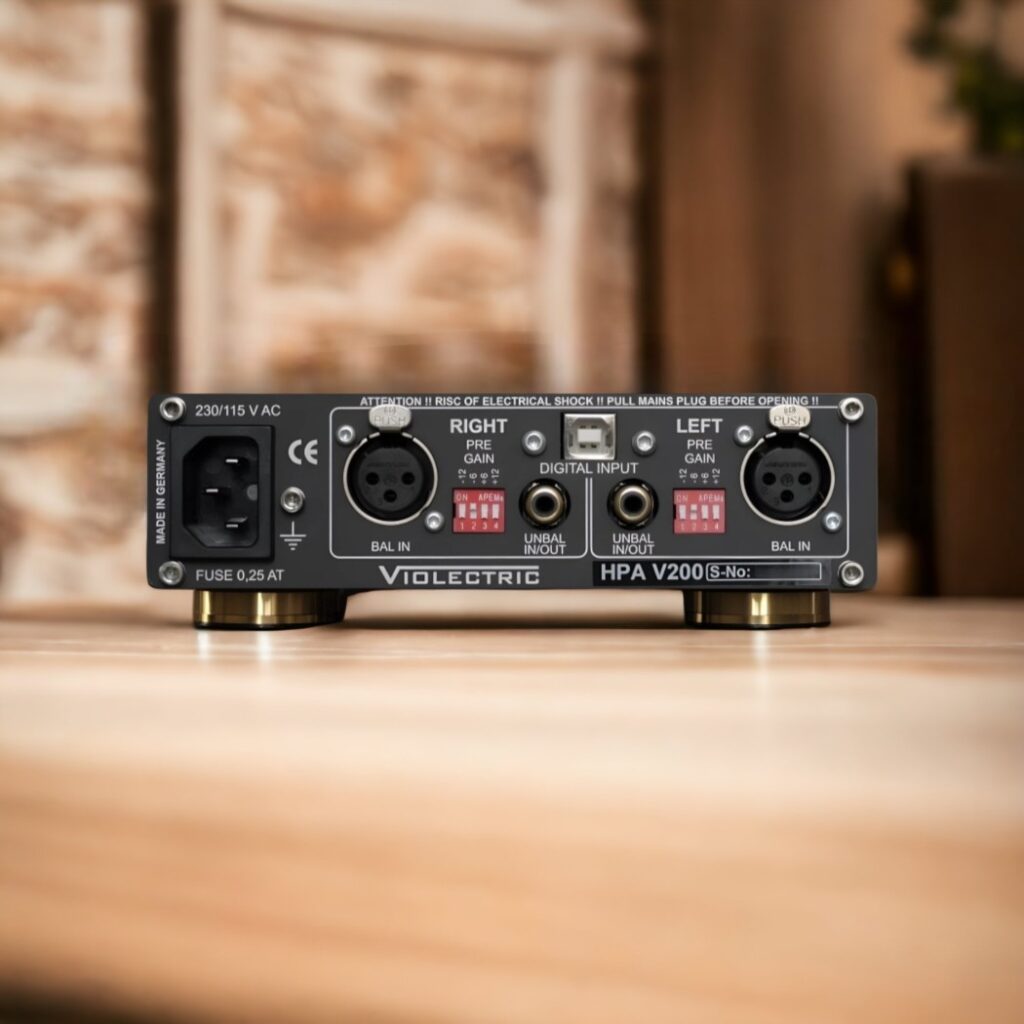
Heed Canalot mkIII with X-PSU vs Violectric V200
So, having tested the Canalot with a pricey PSU, how does it sound with the standard, switch mode X-PSU? It performs pretty darn good. My first listen is with the LCD-3 and Tom Waits, and the Canalot still impresses me. Comparing it swiftly to the Taurus, my initial response is that it is not that far behind but it is not quite up there. The downgrade is noticeable. Although basic sound signature and tonality remain the same as before, there is a certain loss of headspace, clarity and precision. That being said, I am impressed with the little and now very compact amp. And if I didn’t mention it before, the LCD-3 is great with the Canalot, regardless of the PSU connected. Here is the comparison to the V200 using the small (stock) PSU for the Canalot III:
Focal Elear
Four Ravens – Ill Considered: The V200 has more space and headroom, especially the treble feels a bit more detailed. The Heed is a bit more closed in and muffled sounding in direct comparison. It is still very good, but the loss of the Obelisk PX is noticeable.
Four Seasons, Spring no.2 – Vivaldi/Janine Jansen et.al.: The Heed has a seducing tonality, slightly warmer. But the V200 has that extra fine detail, timbre, and sense of space that makes it objectively better.
Beyerdynamic T1 mkII
Four Seasons, Summer 3 – Vivaldi/Janine Jansen et al: Same thing here as with the Elear, the Heed is very good and has nice warm mids, but is not quite up to the level of detail presented by the V200. Considering the price difference though, I must say I am really impressed with the Heed.
Lost Cause – Beck: The male vocals are different, a bit thicker with the Heed. What is more natural is always hard to say, but the Heed sometimes feels a bit more coloured, though mostly in a welcome way.
Prokofiev´s Violin Concerto No.2, G minor, op 53 – Janine Jansen et.al: The slight extra warmth the Heed offers suits the T1 very well, and even though the V200 has a bit more fine detail, the Heed is nicer overall.
Blood in the Cut – K.Flay: Again, the V200 offers a bit more space around instruments, but the Heed is really not far behind.
Acoustic Research AR-H1
Running some tracks with the AR-H1, the difference is less obvious than with the more expensive headphones I tried so far. The AR-H1 is no slouch in its price class but has a more forgiving character than e.g the T1. Actually, I often end up preferring the Heed because of its warmer and more inviting tone, especially with string music, since I feel the detail level is more similar.
Sennheiser HD650
Another lower-priced headphone. Surely known to grow a lot with the right amp. V200 is not the absolute best match in its price range for the HD650, though – but it works well. Running through a selection of songs, I find that the HD650 reveals the difference between the amps better than the AR-H1. Often I prefer the V200 for a small dose of added clarity, but I almost as often prefer the Heed for its nicer, fuller midrange.
Beyerdynamic DT1770PRO
Similar experience as with the HD650. Great with both, the V200 generally offers a bit of better resolution, and the Heed has that extra warmth.
Hifiman Sundara
Rocket – Smashing Pumpkins: I prefer the slightly fatter sound of the Heed. The V200 doesn’t add anything but a slight dryness.
Your Lady – Medeski, Martin and Wood: With this live recording, the V200´s extra clarity comes to its right. The Heed is a really nice partner for the Sundara, but the V200 is better.
Cassius – Fleet Foxes: The tonality and general presentation of the Heed are more pleasing, but the V200 offers more clarity.
IN CONCLUSION: There is no doubt that the V200 presents a more spacious and detailed sonic picture when the Heed Canalot is left with its least expensive PSU option. But the Canalot still has that extra charm, which not seldom makes it subjectively preferable.
SCHIIT MJOLNIR 1 VS V200
This is the closest I previously got to a review of the V200 when it was still fresh. The Schiit Mjolnir, however, is currently in its 3rd generation and this not really that relevant. However, as a bonus, I include the conclusion from my comparison between these two amps back in the day. The full review is in the link. I compared them using these headphones: Audeze LCD-3, Hifiman HE-500 and HE-6 and Sennheiser HD650.
In conclusion, Mjolnir is the more aggressive one, with a sharper edge in the higher regions and a tighter bass. It is to some extent more of a detail freak, pointing out that detail with a pointing finger. The V200 on the other hand has a fuller bass, smoother highs and more liquid mids. It has plenty of detail but it’s not always putting them in your face like the Mjolnir does. V200 also excels on creating a sense of soundstage depth, a quality I really was a bit disappointed with in the Mjolnir. But hey – they are both great amps – and beautiful pieces of audio gear. They feel like quality, they sound like quality.
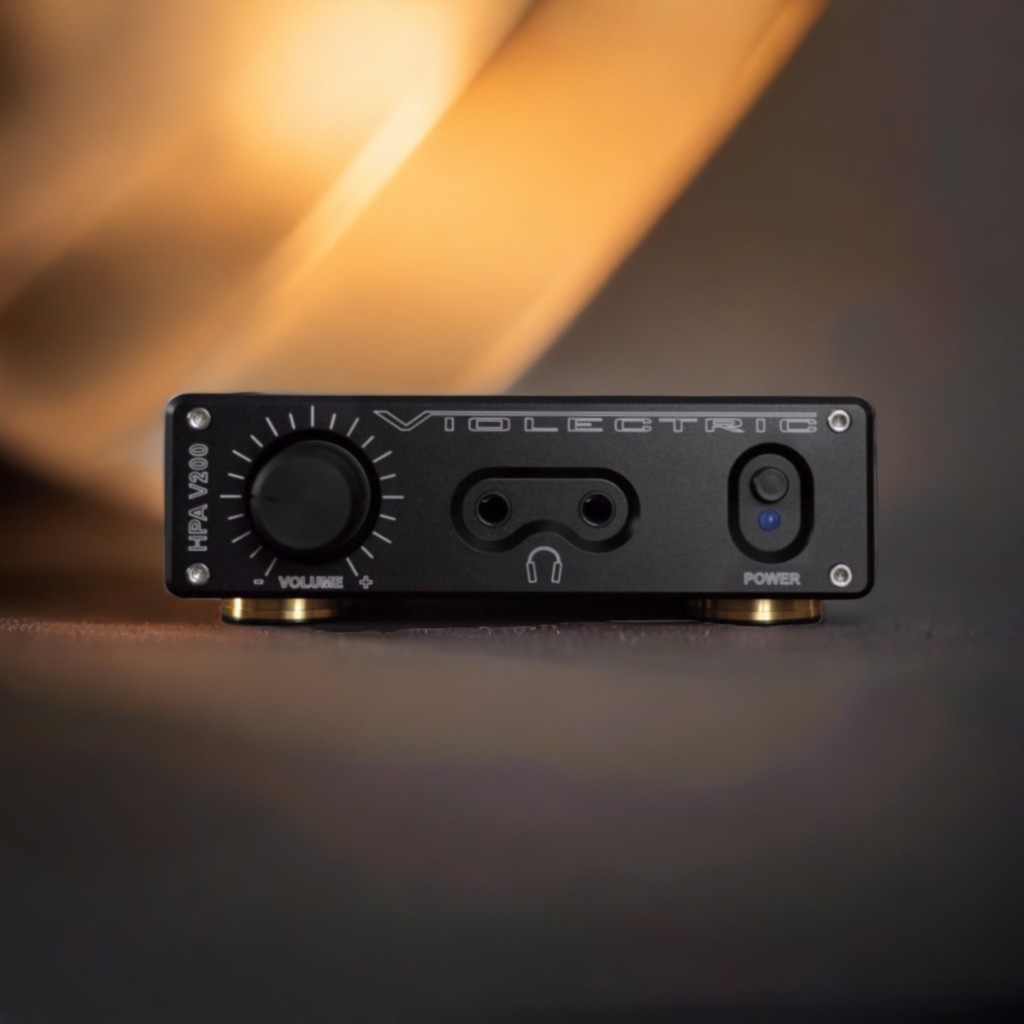
CONCLUSION
In my opinion, the Violectric HPA V200 stands out as one of the most significant headphone amplifiers ever made. It played a crucial role at the beginning of the modern era of planar magnetic headphones. It propelled Violectric into prominence within the audiophile market and served as both inspiration and competition for others entering the field. It also served as the foundation for the V281, a dual-mono version of the V200. Even though Violectric has since introduced a new lineup, the legacy of the V200 lives on. The significance of the V200 is underscored by the fact that Violectric has decided to reissue the V281.
Following the discontinuation of the V200, I entrusted it to a dear friend, a man of exquisite taste, who likely will treasure and care for it throughout its lifespan. The V200 will forever occupy a cherished corner of my audiophile heart, and I find great significance in the fact that it has found a deserving, new home.
Check out Violectric on Amazon here
We make earnings through affiliate links and any purchase you make on Amazon or Linsoul clicking one of our links will give us a small provision at no cost to you.
We only get a provision for items that are not returned, so there’s no incentive for us to recommend something that’s not good.
Linsoul : Headphones, Earbuds, Wireless Earbuds, Desktop DAC/AMP, Portable DAC/AMP, Digital Audio Players,
Amazon: Headphones, IEMs, Headphone Amplifiers, Home Audio or Anything else.
.
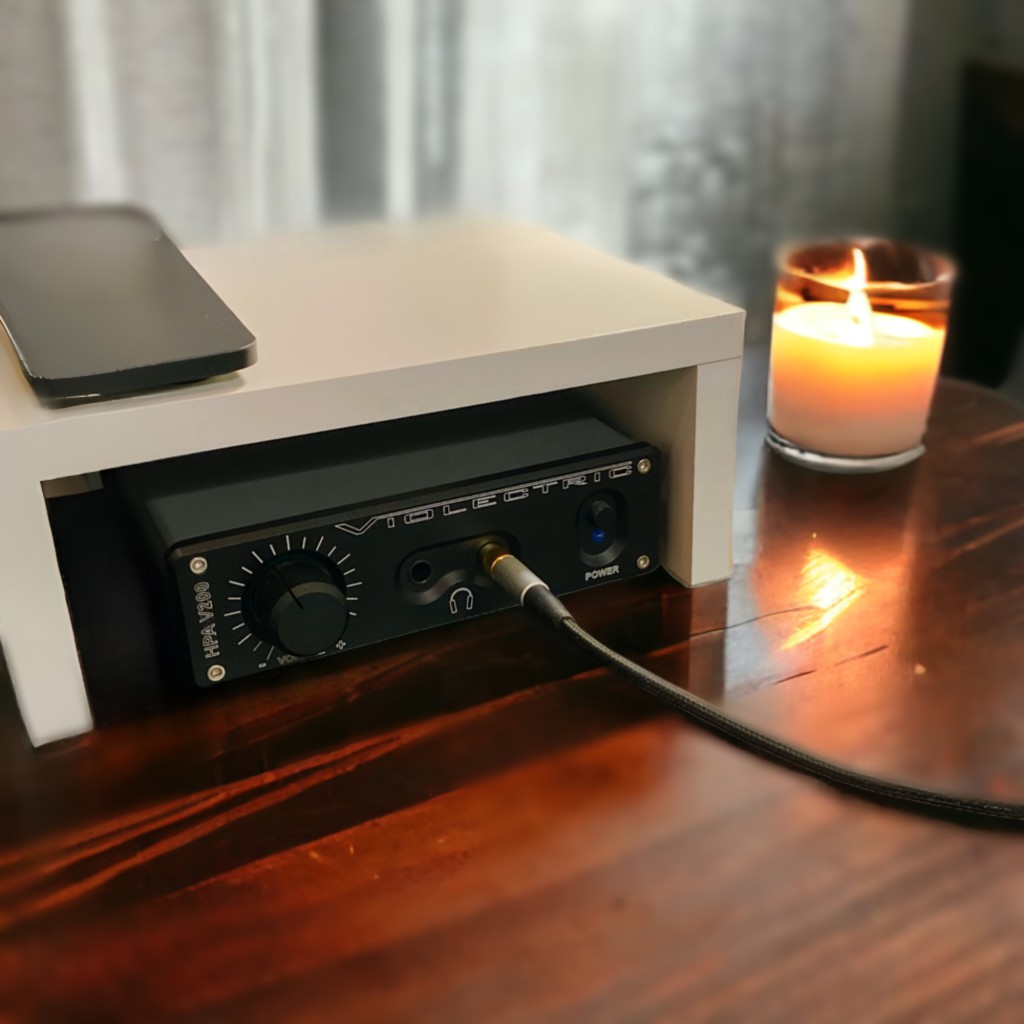
POWER OUTPUT COMPARED
V200 Power Output:
- 600 Ohms / 570 mW / 18,5 Veff
- 100 Ohms / 2200 mW / 14,8 Veff
- 50 Ohms / 2700 mW / 11,6 Veff
- 32 Ohms / 2000 mW / 8,0 Veff
- 16 Ohms / 1000 mW / 4,0 Veff
V202 Power Output:
- 600 Ohms / 570 mW / 18,5 Veff
- 300 Ohms / 930 mW / 16,7 Veff
- 100 Ohms / 2200 mW / 14,8 Veff
- 50 Ohms / 2700 mW / 11,6 Veff
- 32 Ohms / 1700 mW / 8,0 Veff
- 16 Ohms / 1500 mW / 4,0 Veff
V220 Power Output:
- 600 Ohms / 670 mW / 20 Veff
- 300 Ohms / 2650 mW / 28.2 Veff
- 100 Ohms / 3050 mW / 17.5 Veff
- 50 Ohms / 2700 mW / 11.6 Veff
- 32 Ohms / 2800 mW / 9.5 Veff
- 16 Ohms / 1500 mW / 4.9 Veff
V222 Power Output:
- 600 Ohms / 900 mW / 23,2 Veff
- 300 Ohms / 1800 mW / 23,2 Veff
- 100 Ohms / 3500 mW / 18,7 Veff
- 50 Ohms / 2800 mW / 11,8 Veff
- 32 Ohms / 2200 mW / 8,4 Veff
- 16 Ohms / 1500 mW / 4,9 Veff
V280 Power Output:
- 600 Ohms / 1800 mW / 32.9 Veff
- 300 Ohms / 2650 mW / 28.2 Veff
- 100 Ohms / 5300 mW / 23.0 Veff
- 50 Ohms / 3100 mW / 12.4 Veff
- 32 Ohms / 2600 mW / 9.1 Veff
- 16 Ohms / 1500 mW / 4.9 Veff
V281 Power Output
- 600 Ohms / 2700 mW / 40.0 Veff
- 100 Ohms / 5600 mW / 23.7 Veff
- 50 Ohms / 4200 mW / 14.5 Veff
- 32 Ohms / 2800 mW / 9.5 Veff
- 16 Ohms / 1500 mW / 4.9 Veff
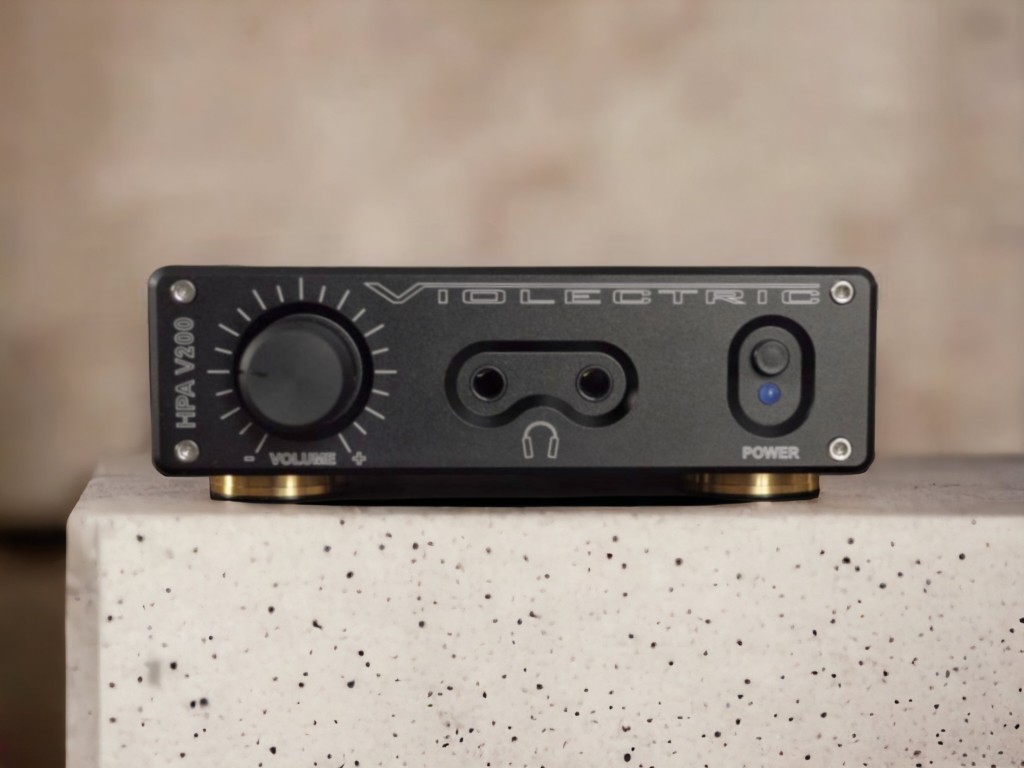
V200 SPECIFICATIONS
- Outputs: 2 x 1/4″ phone jacks
- Power supply: 230 / 115 V AC 10 VA
- Dimensions: 170 x 49 x 225 mm (WxHxD)
- Case Material: Black anodized aluminium
- Balanced Inputs: 2, gold-plated XLR connectors
- Unbalanced Inputs: 2, gold plated RCA connectors
- Input impedance: 10 kohms
- Unbalanced Outputs: 2, gold-plated RCA connectors
- Amplifier Channels: 2 (Stereo)
- Nom. input level: + 6 dBu
- Amplifier Gain: +8 dB … with PRE-GAIN: -4 / +8 / +14 dB
- Frequency range: 0 Hz … 60 kHz (-0,5 dB)
- Output Impedance: 0,06 Ohms
- Dynamic range: > 128 dB (A-wtd)
- Noise: < -100 dBu (A-wtd)
- THD+N: < -110 dB @ 10V in 100 Ohms (1W) / < -103 dB @ 4V in 32 Ohms (0,5W)
- Crosstalk: < -110 / -95 dB (@ 1 / 15 kHz)
- Supply voltage: 230 V AC / 115 V AC max. 10 VA
- Front, Back: 5 mm / 2,5 mm Aluminum, black anodized
- Case: 3 mm / 4 mm Aluminum, black anodized
- Case dimensions: 165 x 54 x 228 mm (W x H x D)
- Overall dimensions: 170 x 65 x 252 mm (W x H x D)
V200 Headphone Power Output:
- 600 Ohms / 570 mW / 18,5 Veff
- 100 Ohms / 2200 mW / 14,8 Veff
- 50 Ohms / 2700 mW / 11,6 Veff
- 32 Ohms / 2000 mW / 8,0 Veff
- 16 Ohms / 1000 mW / 4,0 Veff
For comparisons here are the full specifications of the new version V202. As you can see the specifications are very similar but not identical.
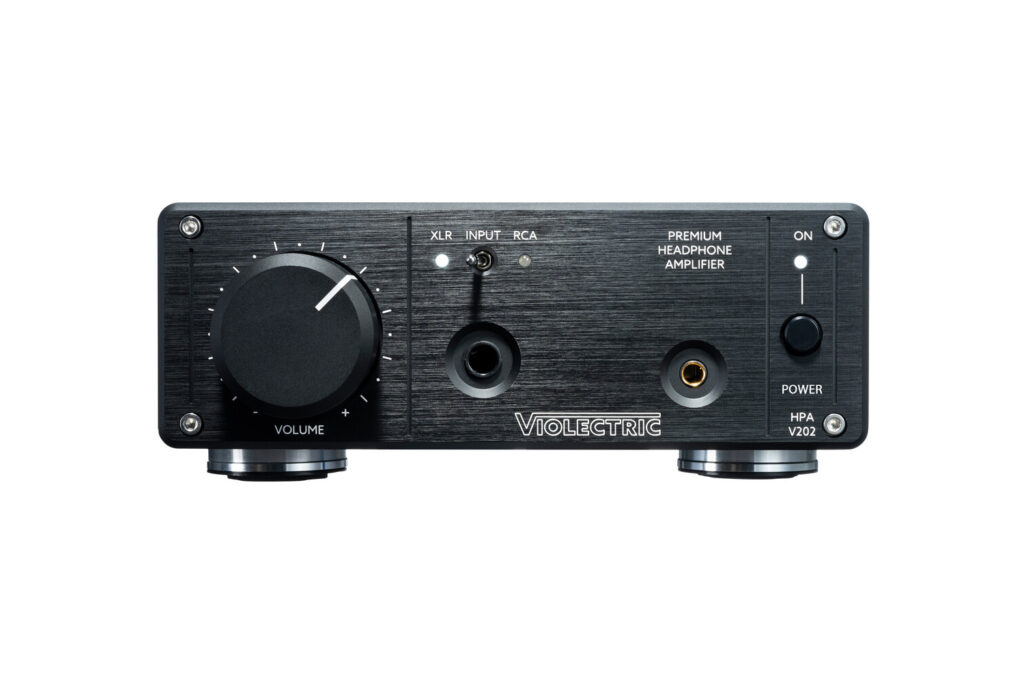
V202 SPECIFICATIONS
(All Data RMS unwtd., 20 Hz – 20 kHz, Pre-Gain set to 0 dB)
- Inputs (stereo): 1 x XLR balanced, 1 x RCA, unbalanced
- Max. input voltage: + 21 dBu,
- Input impedance: 10 Kohm
- Nominal input sensitivity: +6 dBu
- Feedback gain: +8 dB
- PRE-GAIN: -18 / -12 / -6 / 0 / +6 / +12 / +18 dBr
- Frequency range: 5 Hz to 250 kHz (- 0,5 dB)
- Output impedance: 0,25 Ohm
- Damping factor (Load 50 R): 200
- Dynamic range: > 128 dB (A-wtd)
- Noise: < -100 dBu (A-wtd)
- THD+N (1kHz/2x10V/100R=1W): < -100 dB / < 0,001 %
- THD+N (1kHz/2x4V/32R=0,5W): < -103 dB / < 0.0007 %
- Crosstalk: -100 dB (1 kHz) / -95 dB (15 kHz)
- Supply voltage: 230 V AC / 115 V AC max. 15 VA
- Front, Back: 5 mm / 2,5 mm Aluminum, black anodized
- Case: 4 mm Aluminum, black anodized
- Case dimensions: 165 x 54 x 228 mm (W x H x D)
- Overall dimensions: 170 x 65 x 252 mm (W x H x D)
V202 Headphone Power Output:
- 600 Ohms / 570 mW / 18,5 Veff
- 300 Ohms / 930 mW / 16,7 Veff
- 100 Ohms / 2200 mW / 14,8 Veff
- 50 Ohms / 2700 mW / 11,6 Veff
- 32 Ohms / 1700 mW / 8,0 Veff
- 16 Ohms / 1500 mW / 4,0 Veff
